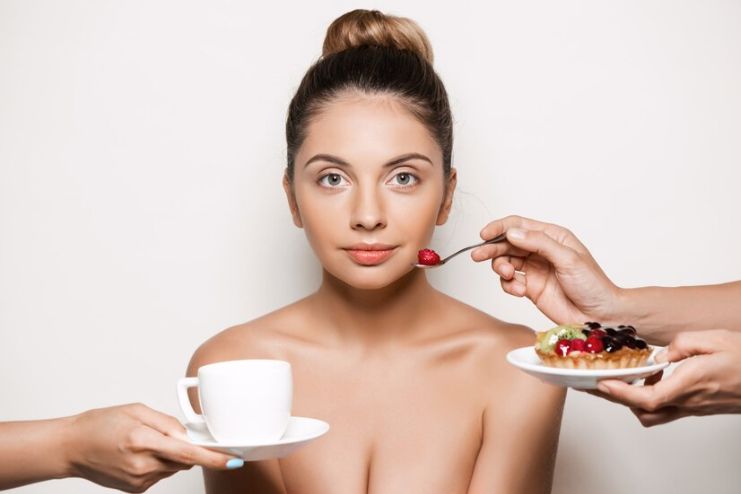AI Contribution
At HealthSpectra, we may use AI to refine grammar and structure, but every piece is shaped, checked, and approved by real people, our expert writers and editors, to ensure clarity, credibility, and care. Learn more..Affiliate Disclaimer
Some links in this article are affiliate links. We may earn a small commission if you make a purchase through these links, at no extra cost to you. We only recommend products we find useful to our readersCould your favorite snacks and meals be sabotaging your skin goals?
Your diet may play a bigger role in acne breakouts than you realize. From hormonal imbalances to inflammation, the foods you eat can either fuel acne or help fight it. If you’ve been wondering how to achieve clearer skin naturally, this guide is for you.
In this article, we’ll uncover the surprising connection between what’s on your plate and what’s on your face. Discover 10 common foods that might be triggering your breakouts and learn about the best anti-inflammatory, acne-fighting alternatives to include in your diet for radiant, glowing skin.
The Science Behind Diet and Acne

The relationship between diet and acne is more than just skin-deep. What you eat influences key factors contributing to breakouts, such as oil production, inflammation, and hormonal balance.
1. Oil Production and Clogged Pores
Some foods, especially those rich in refined sugars and unhealthy fats, can stimulate your sebaceous glands to overproduce oil (sebum). When combined with dead skin cells, this oil may block pores, providing an ideal setting for acne-causing bacteria to multiply.
2. Inflammation and Skin Health
Inflammation is a major cause of acne, causing the skin to become red, swollen, and irritated. Diets rich in processed and sugary foods are associated with higher levels of systemic inflammation, exacerbating the condition. Conversely, anti-inflammatory foods, omega-3 fatty acids, and leafy greens may help soothe inflammation and reduce breakouts.
3. Hormonal Imbalances
High-glycemic carbohydrates make blood sugar fluctuate; consequently, so does the release of insulin, which subsequently prompts the body to produce IGF-1, a hormone that helps stimulate sebum production and skin cell turnover, factors involved in causing acne.
Hormonal changes, like increased androgen levels during the menstrual cycle or in PCOS, cause an increase in oil production and pores getting clogged, which contributes to more breakouts.
Certain foods also have growth hormones that can cause more acne by stimulating these hormonal imbalances.
4. Gut Health and Acne
New research has linked gut health to skin health, popularly known as the gut-skin axis (R). A diet devoid of fiber and probiotics causes an imbalance in gut bacteria, leading to inflammation and potential skin issues. Ingestion of probiotic-rich foods and fiber can help with gut health and improve skin clarity.
Understand how diet impacts these mechanisms and make informed choices that support healthier, clearer skin. A balanced, nutrient-rich diet that minimizes acne triggers and emphasizes anti-inflammatory foods is the key to breaking the cycle of breakouts.
10 Foods That Can Cause Acne

Your diet plays a critical role in your skin’s health. Some foods have been known to exacerbate acne by stimulating oil production, inflammation, and hormonal imbalance. Here are the top culprits to avoid:
1. Dairy Products
Dairy products such as milk, cheese, and ice cream may taste great, but they can contribute to acne. Dairy contains hormones that may stimulate your oil glands and increase inflammation, leading to clogged pores and breakouts.
2. Refined Sugars and Sweets
Sugary foods like candy, cakes, and sodas cause blood sugar spikes, triggering insulin production. High insulin levels increase oil production and inflammation, both of which can exacerbate acne.
3. Processed Foods
Chips, packaged snacks, and frozen meals contain unhealthy fats, preservatives, and additives that cause inflammation. They are empty calories that do not contain nutrients supporting healthy skin, a double whammy.
4. Fast Food
Burgers, fries, and pizzas contain a lot of trans fats and refined carbs, which increase the level of inflammation and contribute to increased oil production from the skin, which in turn worsens acne.
5. White Bread and Pasta
White bread, pasta, and pastries contain refined carbohydrates with a high glycemic index. These raise the blood sugar very quickly, thus resulting in a sudden increase of insulin, causing acne-related hormonal changes.
6. Chocolate
While dark chocolate can be consumed in moderation as it has various health benefits, milk chocolate remains a common trigger for acne. It contains sugar and dairy, which both contribute to inflammation and hormonal imbalances.
7. Greasy and Fried Foods
Oily foods ruin your stomach and clog your pores. Consuming greasy foods may also increase the production of sebum, which leads to breakouts.
8. Alcohol
Alcohol dehydrates the skin and makes it unable to repair itself. It also disrupts the liver’s functionality, and sometimes, it may not detoxify your body correctly, causing breakouts.
9. Soy Products
Soy contains phytoestrogens, which act like estrogen in the body. This can cause hormonal imbalances, especially for those who are sensitive to fluctuations in estrogen levels, and may cause acne.
10. Whey Protein
Whey protein is popular among fitness enthusiasts but is known to raise insulin-like growth factor 1 (IGF-1). This hormone encourages oil production and causes more breakouts, particularly along the jawline.
Reduce or avoid such acne-inducing foods, and you go a long way toward having clear, healthy skin. Instead, consume nutrient-rich, anti-inflammatory options that nourish your body and calm your skin.
10 Foods to Eat for Clearer Skin

A nutrient-rich and anti-inflammatory diet can do wonders for your skin. Incorporation of the right food in the diet helps curb inflammation, the regulation of oil, and the wonder of healthy skin. Here’s what you must eat for a glowing, pimple-free countenance:
1. Leafy Greens and Vegetables
They are rich in vitamins A, C, and E, antioxidants that battle free radicals that cause inflammation within the skin, and support skin repair and defense against damage. Examples of greens are spinach, kale, broccoli, etc.
2. Omega-3 Fatty Acids
Omega-3s have high anti-inflammatory and oil-regulating properties that preserve the moisture barrier for our skin. Try fatty fish, such as salmon and mackerel, or nuts and seeds, like walnuts, flaxseeds, and chia seeds.
3. Low-Glycemic Foods
These balance your sugar levels and decrease insulin spikes, thereby causing less acne. Quinoa, oats, brown rice, and sweet potatoes happen to be low on the glycemic index.
4. Probiotic-Rich Foods
A better gut helps reduce inflammation, which leads to healthy, clearer skin. Yogurt, kefir, kimchi, sauerkraut, and other fermented food products promote balanced gut health by influencing your microbiome.
5. Anti-Inflammatory Fruits
The fruits ease inflammation and contribute to bright skin. Berries such as blueberries, strawberries, raspberries, oranges, and avocados are packed with antioxidants, vitamins, and healthy fats.
6. Zinc-Rich Foods
Zinc controls oil production in the skin, diminishes inflammation, and makes the wounds heal faster. One can find generous amounts of zinc in pumpkin seeds, chickpeas, cashews, and lentils.
7. Herbal Teas
Green tea has epigallocatechin gallate, which helps decrease inflammation and sebum, leading to acne. Green tea and chamomile tea are high in antioxidants and anti-inflammatory agents.
8. Hydrating Foods
Proper hydration removes toxins from the body and helps keep a healthy barrier for the skin. Cucumber, watermelon, and celery have high water content that will hydrate the skin.
9. Vitamin C-Rich Foods
Citrus fruits, bell peppers, and tomatoes are packed with vitamin C, a powerful antioxidant that boosts collagen production and protects against skin damage.
10. Healthy Fats
Olive oil, avocado oil, and nuts contain healthy fats that help to give your skin the elasticity and hydration it needs. These fats decrease inflammation and allow your skin to glow from within.
These foods will not only add to clearer skin but also benefit your overall health. Combine these healthy choices with hydration, proper exercise, and a regular skincare routine for ideal skin results.
Building a Diet for Acne-Free Skin

Building a diet of anti-inflammatory and whole foods that supports acne-free skin does not mean sacrificing flavor or fun. It’s all about making thoughtful decisions for your skin and health.
The goal is to create a sustainable eating plan that will nourish your body and help clear your complexion. We will focus on nutrient-dense, whole foods and balance your macronutrients.
Here’s some guidance on how to build a sustainable eating plan that will help improve your skin’s clarity:
Balance Macronutrients
Eat foods rich in the following nutrients:
- Proteins: Eat lean protein sources like fish, poultry, eggs, legumes, and tofu, all of which can assist in repairing and rebuilding the skin.
- Healthy Fats: Consuming more omega-3-rich foods, including salmon, walnuts, and avocados, reduces inflammation.
- Complex Carbohydrates: Low-glycemic foods such as quinoa, oats, and sweet potatoes will stabilize blood sugar.
Meal Planning Tips for Clear Skin
- Breakfast: Blend together spinach, mixed berries, flaxseeds, and unsweetened almond milk.
- Lunch: Mix together greens, grilled chicken, quinoa, and olive oil with lemon.
- Dinner: Baked salmon with roasted sweet potatoes and steamed broccoli.
- Snacks: Nuts, seeds, fresh fruits, or hummus with veggie sticks instead of candy.
Lifestyle Tips to Complement a Clear-Skin Diet

Although diet is important in acne management, lifestyle is equally important. Incorporating these strategies into your life will only add more to a clear-skin diet, making you healthier over time.
1. Follow a Gentle Skincare Routine
Pair this diet with a skincare regimen specific to your skin type. The most important steps are:
- Cleansing: Cleanse with a gentle, non-comedogenic cleanser to remove dirt and excess oil without stripping your skin.
- Moisturizing: Hydrate your skin with a lightweight, oil-free moisturizer to keep it healthy and intact.
- Protecting: Use sunscreen daily to prevent damage from UV rays, which can exacerbate acne scars and inflammation.
2. Avoid Touching Your Face
Frequent touching transfers bacteria and oils from your hands to your face, which raises the risk of clogged pores and breakouts. Keep your hands clean and avoid picking at pimples to prevent scarring.
3. Stay Active
Regular exercise increases blood flow to your body and, subsequently, to your skin, enhancing oxygen and nutrient supply. Physical exercise reduces stress levels, a significant acne-causing trigger. Seek to do at least 30 minutes of moderate exercise, including jogging, yoga, or swimming, most days of the week.
4. Manage Stress Levels
Stress triggers an increase in cortisol levels. This raises the oil produced by your body and leads to breakouts. Use stress-reducing techniques like:
- Meditation or mindfulness exercises
- Deep breathing or progressive muscle relaxation
- Spend time outdoors or do things you like
5. Prioritize Quality Sleep
Poor sleep disrupts hormonal balance and impairs the repair processes in the skin. Ensure you sleep for 7-9 hours at night by going to bed and waking up at the same time every day, avoiding screens one hour before bed, and doing a relaxing bedtime routine.
6. Practice Gut Health Hygiene
Your gut health is connected to the appearance of your skin. Probiotics and fiber-rich foods can be beneficial for maintaining a healthy gut microbiome. Avoid overuse of antibiotics since they may affect your gut bacteria balance.
7. Hydrate Consistently
Hydration is crucial for both gut and skin health. Drinking water helps maintain a healthy glow and prevent dryness, while water-rich foods like cucumbers, watermelon, and oranges nourish your skin from the inside. To support your skin externally, use a humidifier during dry seasons to prevent irritation and moisture loss.
8. Minimize Exposure to Environmental Pollutants
Pollution and toxins can clog pores and cause inflammation. Protect your skin by washing your face properly if you have been exposed to a polluted area and using antioxidant products so that free radical damage doesn’t destroy your cells.
9. Supplement Smartly (If Needed)
A healthy diet is the best source of nutrients, but supplements such as zinc, vitamin D, and probiotics may be beneficial if your diet is lacking in some areas. Just remember to always consult a healthcare professional before beginning any supplements.
10. Keep It Sustainable
Dietary changes can be overwhelming. Instead, make small, manageable changes that will stick in the long term. Gradually shift your diet to an acne-friendly one that is more likely to produce sustainable outcomes.
By building meals with skin-healthy ingredients and living a balanced, hydrated lifestyle, you’re setting the foundation for clearer, healthier skin from within. Once you implement some of these lifestyle practices, you will see positive results in the form of clear skin.
Conclusion
The right products, as well as the foods you eat and the habits you build, are part of the journey to clear, glowing skin. Identify which foods trigger your acne and cut back on those while embracing nutrient-rich, anti-inflammatory options. This will address the root causes of breakouts and help your skin get healthy from the inside out.
Combine these dietary changes with a consistent skincare routine, stress management techniques, and other lifestyle adjustments to maximize your results. Remember, small, sustainable steps can lead to lasting transformations.
Take control of your skin’s future today—start building your diet for acne-free skin and unlock the natural radiance you deserve!
In this Article






















